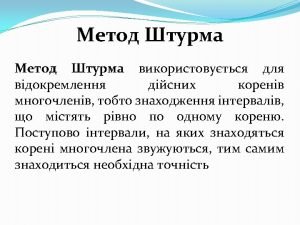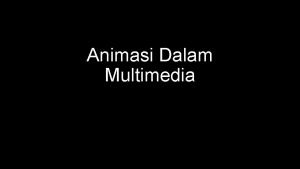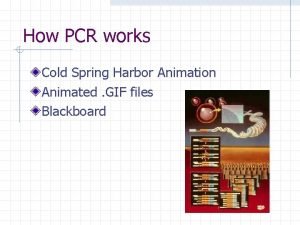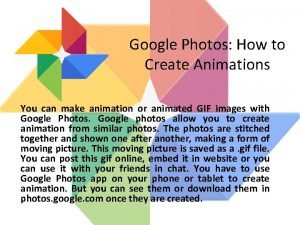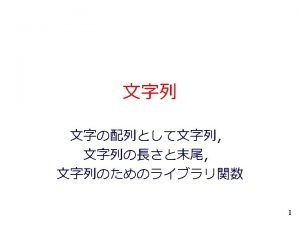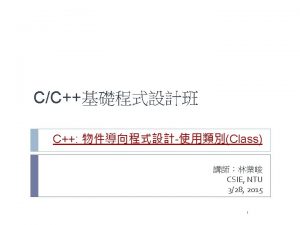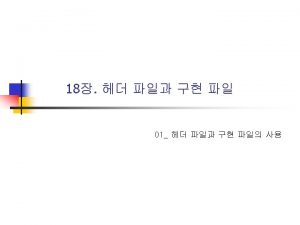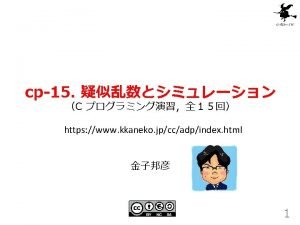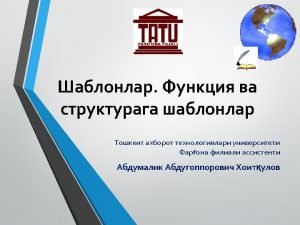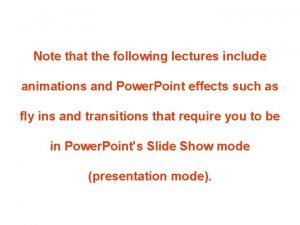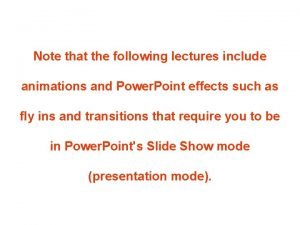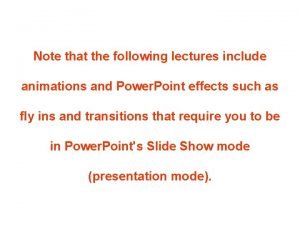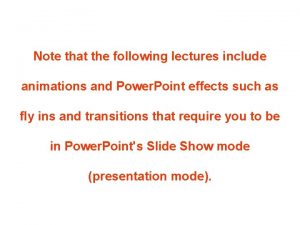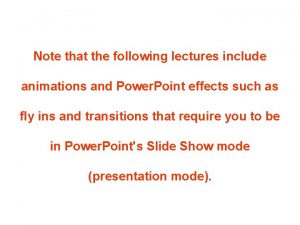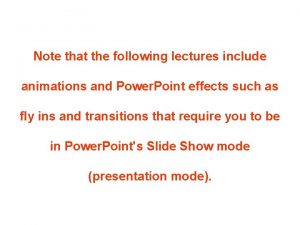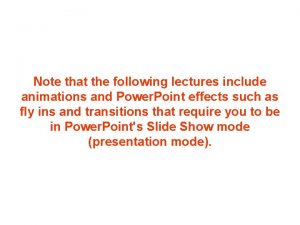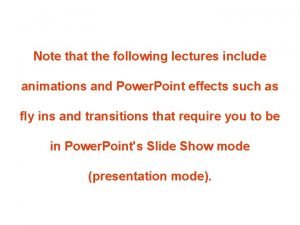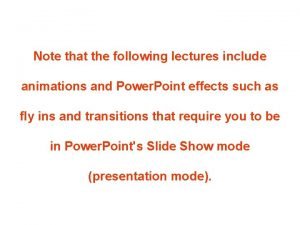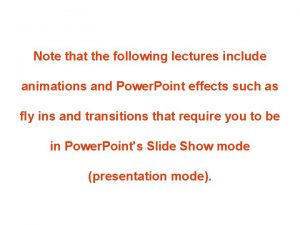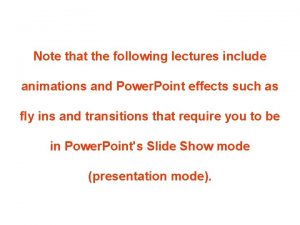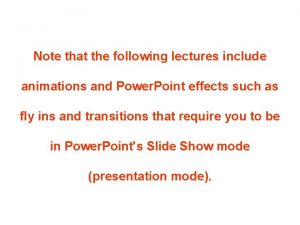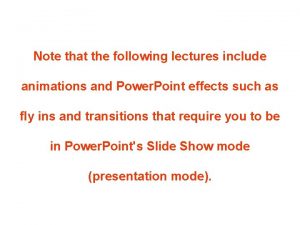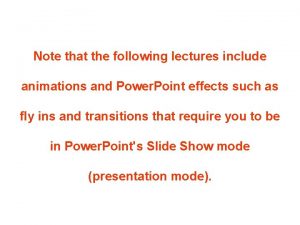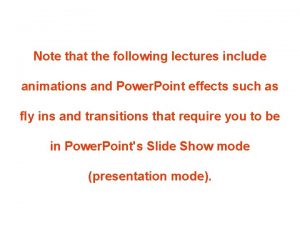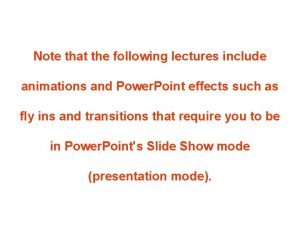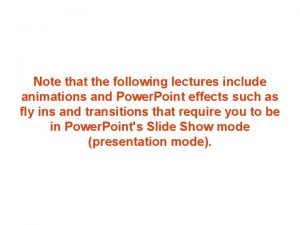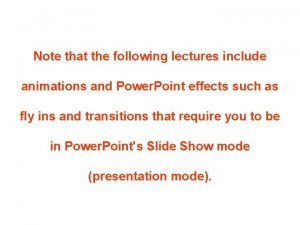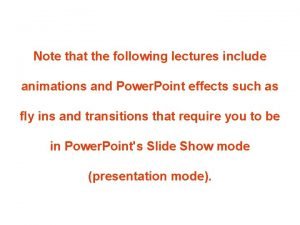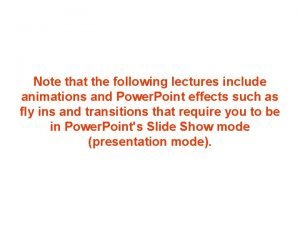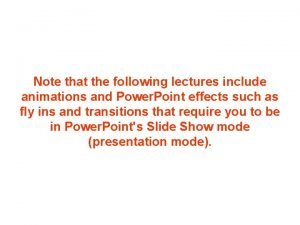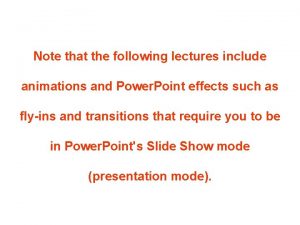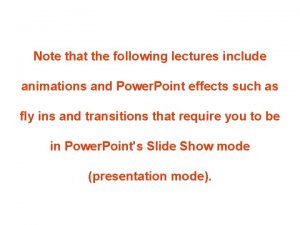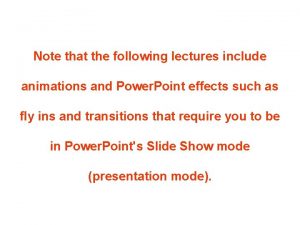Note that the following lectures include animations and



































































- Slides: 67

Note that the following lectures include animations and Power. Point effects such as fly ins and transitions that require you to be in Power. Point's Slide Show mode (presentation mode).

Chapter 21 The Moon and Mercury: Airless Worlds

Guidepost The two preceding chapters have been preparation for the exploration of the planets. In this chapter, we begin that detailed study with two goals in mind. First, we search for evidence to test the solar nebula hypothesis for the formation of the solar system. Second, we search for an understanding of how planets evolve once they have formed. The moon is a good place to begin because people have been there. This is an oddity in astronomy in that astronomers are accustomed to studying objects at a distance. In fact, many of the experts on the moon are not astronomers but geologists, and much of what we will study about the moon is an application of earthly geology.

Guidepost (continued) While no one has visited Mercury, we will recognize it as familiar territory. It is much like the moon, so our experience with lunar science will help us understand Mercury as well as the other worlds we will visit in the chapters that follow.

Outline I. The Moon A. The View From Earth B. Highlands and Lowlands C. The Apollo Missions D. Moon Rocks E. The History of the Moon F. The Origin of Earth's Moon II. Mercury A. Rotation and Revolution B. The Surface of Mercury C. The Plains of Mercury D. The Interior of Mercury E. A History of Mercury

The Moon: The View from Earth From Earth, we always see the same side of the moon. Moon rotates around its axis in the same time that it takes to orbit around Earth: Tidal coupling: Earth’s gravitation has produced tidal bulges on the moon; Tidal forces have slowed rotation down to same period as orbital period

Lunar Surface Features Two dramatically different kinds of terrain: • Highlands: Mountainous terrain, scarred by craters • Lowlands: ~ 3 km lower than highlands; smooth surfaces: Maria (pl. of mare): Basins flooded by lava flows

Highlands and Lowlands Sinuous rilles = remains of ancient lava flows May have been lava tubes which later collapsed due to meteorite bombardment. Apollo 15 landing site

The Highlands Saturated with craters Older craters partially obliterated by more recent impacts … or flooded by lava flows

Impact Cratering Impact craters on the moon can be seen easily even with small telescopes. Ejecta from the impact can be seen as bright rays originating from young craters

The Moon’s Craters (SLIDESHOW MODE ONLY)

History of Impact Cratering Rate of impacts due to interplanetary bombardment decreased rapidly after the formation of the solar system. Most craters seen on the moon’s (and Mercury’s) surface were formed within the first ~ 1/2 billion years.

Missions to the Moon Major challenges: Need to carry enough fuel for: • in-flight corrections, • descent to surface, • re-launch from the surface, • return trip to Earth; need to carry enough food and other life support for ~ 1 week for all astronauts on board. Solution: • only land a small, light lunar module; • leave everything behind that is no longer needed. Lunar module (LM) of Apollo 12 on descent to the surface of the moon

The Apollo Missions

Apollo Landing Sites First Apollo missions landed on safe, smooth terrain. Later missions explored more varied terrains. Apollo 17: Taurus-Littrow; lunar highlands Apollo 11: Mare Tranquilitatis; lunar lowlands

Apollo Landing Sites (2) Selected to sample as wide a variety as possible of different lowland highland terrains. Lowlands (maria) Highlands

Moon Rocks All moon rocks brought back to Earth are igneous (= solidified lava) No sedimentary rocks => No sign of water ever present on the moon. Different types of moon rocks: Vesicular Breccias (= fragments of (= containing holes different types of rock from gas bubbles in cemented together), also the lava) basalts, containing anorthosites (= typical of dark rocks bright, low-density rocks found in maria typical of highlands) Older rocks become pitted with small micrometeorite craters

The History of the Moon is small; low mass rapidly cooling off; small escape velocity no atmosphere unprotected against meteorite impacts. Moon must have formed in a molten state (“sea of lava”); Heavy rocks sink to bottom; lighter rocks at the surface No magnetic field small core with little metallic iron. Surface solidified ~ 4. 6 – 4. 1 billion years ago. Heavy meteorite bombardment for the next ~ 1/2 billion years. Alan Shepard (Apollo 14) analyzing a moon rock, probably ejected from a distant crater.

Formation of Maria Impacts of heavy meteorites broke the crust and produced large basins that were flooded with lava

Formation of Maria (2) Major impacts forming maria might have ejected material over large distances. Apollo 14 Large rock probably ejected during the formation of Mare Imbrium (beyond the horizon!)

Origin of Mare Imbrium Terrain opposite to Mare Imbrium is jumbled by seismic waves from the impact.

The Origin of Earth’s Moon Early (unsuccessful) hypotheses: Fission hypothesis: Break-up of Earth during early period of fast rotation Problems: No evidence for fast rotation; moon’s orbit not in equatorial plane capture hypothesis: Condensation hypothesis: Capture of moon that formed elsewhere in the solar system Problem: Requires succession of very unlikely events Condensation at time of formation of Earth Problem: Different chemical compositions of Earth and moon

Modern Theory of Formation of the Moon The Large-Impact Hypothesis • Impact heated material enough to melt it consistent with “sea of magma” • Collision not head-on Large angular momentum of Earth-moon system • Collision after differentiation of Earth’s interior Different chemical compositions of Earth and moon

Bellwork: Copy the essential question • EQ: How does Mercury compare to the moon? • Standard: 9 B The student is expected to compare the planets in terms of orbit, size, composition, rotation, atmosphere, natural satellites, and geological activity;

WHAT DO YOU THINK? • Which of the two planets, Mercury (the closest planet to the Sun) or Earth, has the coolest temperature? • Which planet is most similar to Earth? • What is the composition of the clouds surrounding Venus? • Does Mars have liquid water on its surface today? • Is life known to exist on Mars today?


Mercury Very similar to Earth’s moon in several ways: • Small; no atmosphere • lowlands flooded by ancient lava flows • heavily cratered surfaces Most of our knowledge based on measurements by Mariner 10 spacecraft (1974 - 1975) View from Earth

Mercury is only Slightly Larger than the Moon OUR MOON MERCURY

Rotation and Revolution Like Earth’s moon (tidally locked to revolution around Earth), Mercury’s rotation has been altered by the sun’s tidal forces, but not completely tidally locked: Revolution period = 3/2 times rotation period Revolution: ≈ 88 days Rotation: ≈ 59 days Extreme day-night temperature contrast: 100 K (-173 o. C) – 600 K (330 o. C)

Mercury’s rotation is coupled with its orbital period around the Sun. There are three sidereal rotations of Mercury for every two orbits around the Sun. This unique combination makes a “solar day” on Mercury last two Mercury years.

Next transit: May 9, 2016

The Surface of Mercury Very similar to Earth’s moon: Heavily battered with craters, including some large basins. Largest basin: Caloris Basin Terrain on the opposite side jumbled by seismic waves from the impact.

Impact craters on Mercury have similar features to those on the Moon. CRATERS ON BOTH MERCURY AND THE MOON HAVE RINGS OF MOUNTAINS SURROUNDING THEM MERCURY OUR MOON Jumbled hills surrounding the Caloris Impact Basin

Mercury also has numerous long cliffs, called scarps, believed to have formed when the planet cooled

Caloris Basin CALORIS BASIN It is a Large Basin that almost split planet in two. Planet hit with a 60 mile wide iron Meteor. Leaving the LARGEST CRATER IN THE S. S.

Caloris Basin • The impact was so great that shock waves traveled through the planet and shook up the terrain on the opposite side!

Lobate Scarps Curved cliffs, probably formed when Mercury shrank while cooling down

The Plains of Mercury No large maria, but intercrater plains: Marked by smaller craters (< 15 km) and secondary impacts Smooth plains: Even younger than intercrater plains

The Interior of Mercury Large, metallic core. Over 60% denser than Earth’s moon Magnetic field only ~ 0. 5 % of Earth’s magnetic field. Difficult to explain at present: Liquid metallic core should produce larger magnetic field. Solid core should produce weaker field.

Mercury’s iron core takes up a much larger percentage of its volume than that of Earth.

One possible theory to explain Mercury’s high iron content is a collision with a massive asteroid that stripped Mercury of most of its rocky mantle.

History of Mercury Dominated by ancient lava flows and heavy meteorite bombardment. Radar image suggests icy polar cap.

Other Mercury Stuff • Mercury has a magnetic field 1% as strong as Earth’s, but its source is not known. • Mercury has no permanent atmosphere. Why is that? • Mercury’s surface temperature range is the biggest in the Solar System: ØNoon = 700 K (800 F) ØNight = 100 K (-280 F)

New Space Mission to Mercury • The Messenger spacecraft was launched in 2004, and will reach Mercury orbit in 2011. (it crashed on Mercury in 2015) • On its way to Mercury, Messenger will loop around Venus twice and around Mercury three times. Then it will enter orbit around Mercury. • Why are we making Messenger do loops around Venus and Mercury?

New Terms tidal coupling terminator limb mare sinuous rille ejecta ray secondary crater micrometeorite multiringed basin relative age absolute age vesicular basalt anorthosite breccia regolith jumbled terrain fission hypothesis condensation hypothesis capture hypothesis large-impact hypothesis resonance lobate scarp intercrater plain smooth plain

Discussion Questions 1. Old science-fiction paintings and drawings of colonies on the moon often showed very steep, jagged mountains. Why did the artists assume that the mountains would be more rugged than mountains on Earth? Why are lunar mountains actually less rugged than mountains on Earth? 2. From your knowledge of comparative planetology, propose a description of the view that astronauts would have if they landed on the surface of Mercury.

Quiz Questions 1. Why does the same side of the Moon always face Earth? a. The Moon does not rotate. b. The Moon rotates in the same direction that it revolves. c. The Moon's period of rotation is equal to its orbital period. d. Sometimes the backside of the Moon is lit by the Sun. e. Both b and c above.

Quiz Questions 2. How did the Moon achieve its synchronous rotation? a. When the Moon formed it just happened to have this synchronous rotation. b. The Earth raises tidal bulges on the Moon. As the Moon rotated through these bulges, internal friction slowed the Moon's rotation until it achieved tidal coupling. c. Competing gravitational tugs on the Moon by the Earth and Sun set up this synchronous rotation. d. The Moon pulls up a tidal bulge on Earth, and Earth rotates so fast that it has locked the Moon into this synchronous rotation. e. As the Earth and Moon orbited their common center of mass, the centrifugal forces sent the Moon outward until this synchronous rotation was achieved.

Quiz Questions 3. How do we know that Copernicus is a young impact crater? a. It is on the side of the Moon that faces Earth. b. It has a central peak and raised rim. c. It has scalloped slopes along its inner crater walls. d. Blocks of material in its ejecta formed secondary craters. e. It has bright rays that extend onto the surrounding maria.

Quiz Questions 4. How do we find the relative ages of the Moon's maria and highlands? a. By counting the number of impact craters. b. By measuring the depth of the lunar regolith. c. By measuring the lunar latitude and longitude. d. By measuring the size of the smallest impact craters. e. By measuring variations in the Moon's gravitational field.

Quiz Questions 5. Why do almost all impact craters have a circular shape? a. High-speed projectiles vaporize explosively upon impact, sending out spherical compression waves. b. The impacting projectiles have a spherical shape and thus punch out circular penetration holes. c. Erosion has reduced the irregular craters to circular shapes. d. Most impacts occur from directly overhead. e. A circle is the most perfect form.

Quiz Questions 6. Why did the first Apollo missions land on the maria? a. The most interesting geology is at these locations. b. To maintain a continuous communication link with the command module. c. To search for fossils that are more likely to exist where water was once present. d. It was thought to be safer due to the smoother terrain and thinner regolith. e. The lunar air is thicker at low elevation.

Quiz Questions 7. Why do we suppose that the Moon formed with a molten surface? a. The Moon is covered with volcanic craters of all sizes. b. Samples from the maria regions are basalt, a common igneous rock. c. The oldest lunar rock samples are about 4. 4 billion years old and composed of anorthosite, a mineral that crystallizes and rises to the top of a lava ocean. d. Both a and b above. e. All of the above.

Quiz Questions 8. What are the characteristics of a rock that is a breccia? a. Breccia is igneous rock, with large crystals that form by slow cooling of magma deep beneath the surface. b. Breccia is igneous rock, with small crystals that form by rapid cooling of lava flows on the surface. c. Breccia is rock consisting of broken rock fragments that are cemented together by heat and pressure. d. Breccia is a sedimentary rock composed of calcium and magnesium carbonates. e. Breccia is sedimentary rock formed by the evaporation of salty shallow seas.

Quiz Questions 9. Why are so many lunar rock samples breccias? a. The many violent volcanic eruptions have formed a lot of breccia. b. The numerous impact events produce a lot of brecciated rock. c. Slow evaporation of shallow seas in the maria regions left breccia deposits. d. Plate motion has pushed the deeply formed breccias to the lunar surface. e. Carbon dioxide dissolves in water, combines with calcium, and precipitates onto the sea floor. These deposits are later lithified by the heat and pressure that accompany deep burial. Impact events bring the breccias to the lunar surface.

Quiz Questions 10. On the large scale, which of the four states of development of a planetary body could be termed arrested development in the case of the Moon? a. Melting and differentiation. b. Impact cratering. c. Flooding of low-lying regions. d. Slow surface evolution. e. None of these stages took place on the Moon.

Quiz Questions 11. What single factor resulted in the Moon today being so very much different than the Earth is today? a. The long, continued period of occasional impacts. b. The flooding of lowland basins with basalt. c. The early torrential bombardment. d. The late heavy bombardment. e. The Moon's small size.

Quiz Questions 12. Why does the Moon have large maria on the Earth-facing side, yet no large maria on the opposite side? a. The maria regions are the same on both sides; we normally don't see those on the far side. b. The late heavy bombardment only occurred on the Earthfacing side. c. The maria on the far side are not as dark as those on the near side. d. The Moon's crust is thicker (or elevations higher) on the far side. e. No large impact basins exist on the Moon's far side.

Quiz Questions 13. Which of the following is due to the Moon's small size? a. The Moon has no atmosphere. b. The Moon does not have a dipole magnetic field. c. The Moon does not have plate tectonics. d. The Moon's surface geology is dominated by impact craters. e. All of the above.

Quiz Questions 14. For what reasons do we reject the condensation (double planet) hypothesis of the Moon's origin? a. The Moon has a much lower density than Earth. b. The Moon is very low in volatiles, compared to Earth. c. The Moon is much smaller and less massive than Earth. d. Both a and b above. e. All the above.

Quiz Questions 15. How does the large impact hypothesis explain the Moon's lack of iron? a. The impact occurred before either planetesimal had differentiated and formed an iron core. b. The ejected orbiting material that formed the Moon was initially at a high temperature. c. Both planetesimals were differentiated, and the two iron cores went to Earth. d. The impacting planetesimal was not differentiated and thus had no iron core. e. The Moon's lack of iron is the major problem of the large impact hypothesis.

Quiz Questions 16. How is the planet Mercury similar to Earth's moon? a. Their surfaces both appear heavily cratered by impacts. b. Their lowland regions were flooded by ancient lava flows. c. Their rotational periods are equal to their orbital periods. d. Both a and b above. e. All of the above.

Quiz Questions 17. How is the planet Mercury different than Earth's moon? a. The lowland maria on Mercury are not much darker than the cratered highlands. b. Mercury has a much higher density. c. Mercury has a dipole magnetic field. d. Both a and b above. e. All of the above.

Quiz Questions 18. How do we suppose that the lobate scarps on Mercury's surface formed? a. Lobate scarps are huge dormant lava tubes. b. As Mercury cooled and shrank, the crust wrinkled. c. Plate tectonics created a chain of folded mountains. d. One side along a strike-slip boundary was forced upward. e. As a chain of volcanic mountains along the edge of a subduction zone.

Quiz Questions 19. What is the difference between the intercrater plains and the smooth plains that are found on Mercury, in terms of time of formation? a. The intercrater plains are older than the smooth plains. b. The intercrater plains are younger than the smooth plains. c. These two types of plains formed at the same times at different locations. d. Their times of formation overlap due to the Sun's tidal influence. e. Their times of formation overlap due to the formation of the Caloris Basin.

Quiz Questions 20. What evidence do we have that Mercury has a partially molten, metallic core? a. The rate at which the orbit of Mercury's moon precesses indicates that Mercury has a high-density center. b. The recent volcanic activity seen on Mercury's surface indicates that it still has a molten interior. c. The S waves created by the impact that formed Caloris Basin did not appear on the opposite side of Mercury. And we know that S waves cannot travel through liquids. d. The peculiar tidal coupling of Mercury's spin to its orbit can only be due to a partially molten, metallic core. e. Mercury has a weak dipole magnetic field.

Answers 1. 2. 3. 4. 5. 6. 7. 8. 9. 10. e b e a a d c c b d 11. 12. 13. 14. 15. 16. 17. 18. 19. 20. e d c d e b a e
 #include stdio.h #include conio.h #include stdlib.h
#include stdio.h #include conio.h #include stdlib.h Apa manfaat animasi dalam multimedia?
Apa manfaat animasi dalam multimedia? Impulse-style scroll animations
Impulse-style scroll animations Pcr animations
Pcr animations How to make animation google photos
How to make animation google photos Loffe animations
Loffe animations Animation frame unit
Animation frame unit Phân độ lown
Phân độ lown Block xoang nhĩ
Block xoang nhĩ Thơ thất ngôn tứ tuyệt đường luật
Thơ thất ngôn tứ tuyệt đường luật Thơ thất ngôn tứ tuyệt đường luật
Thơ thất ngôn tứ tuyệt đường luật Walmart thất bại ở nhật
Walmart thất bại ở nhật Tìm vết của đường thẳng
Tìm vết của đường thẳng Con hãy đưa tay khi thấy người vấp ngã
Con hãy đưa tay khi thấy người vấp ngã Tôn thất thuyết là ai
Tôn thất thuyết là ai Gây tê cơ vuông thắt lưng
Gây tê cơ vuông thắt lưng Sau thất bại ở hồ điển triệt
Sau thất bại ở hồ điển triệt Difference between note making and note taking
Difference between note making and note taking Signal phrases
Signal phrases Difference between note making and note taking
Difference between note making and note taking What is debit note and credit note
What is debit note and credit note Debit note tax invoice
Debit note tax invoice Relevance of note making
Relevance of note making Goods received note vs delivery note
Goods received note vs delivery note Simple discount example problems with solutions
Simple discount example problems with solutions #include string.h
#include string.h #include iostream #include string using namespace std
#include iostream #include string using namespace std #include iostream #include string using namespace std
#include iostream #include string using namespace std #include iostream #include cmath
#include iostream #include cmath Include time
Include time #include iostream #include string using namespace std
#include iostream #include string using namespace std Utilities and energy lectures
Utilities and energy lectures What is text linguistics
What is text linguistics Molecular biology lecture
Molecular biology lecture Rick trebino
Rick trebino Lectures paediatrics
Lectures paediatrics Data mining lectures
Data mining lectures Advanced medicinal chemistry
Advanced medicinal chemistry Orthopedic ppt lectures
Orthopedic ppt lectures Ludic space
Ludic space Activity based approach in software project management
Activity based approach in software project management Radio astronomy lectures
Radio astronomy lectures Dr sohail lectures
Dr sohail lectures Introduction to web engineering
Introduction to web engineering Do words have power
Do words have power Frcr physics lectures
Frcr physics lectures Rotating anode
Rotating anode Cs106b lectures
Cs106b lectures Guyton physiology lectures
Guyton physiology lectures Aerodynamics lectures
Aerodynamics lectures Tamara berg husband
Tamara berg husband Power system lectures
Power system lectures Theory of translation lectures
Theory of translation lectures Digital logic design lectures
Digital logic design lectures Compsci 453
Compsci 453 Hegel romantic art
Hegel romantic art Nuclear medicine lectures
Nuclear medicine lectures Cs106b
Cs106b Cdeep lectures
Cdeep lectures
